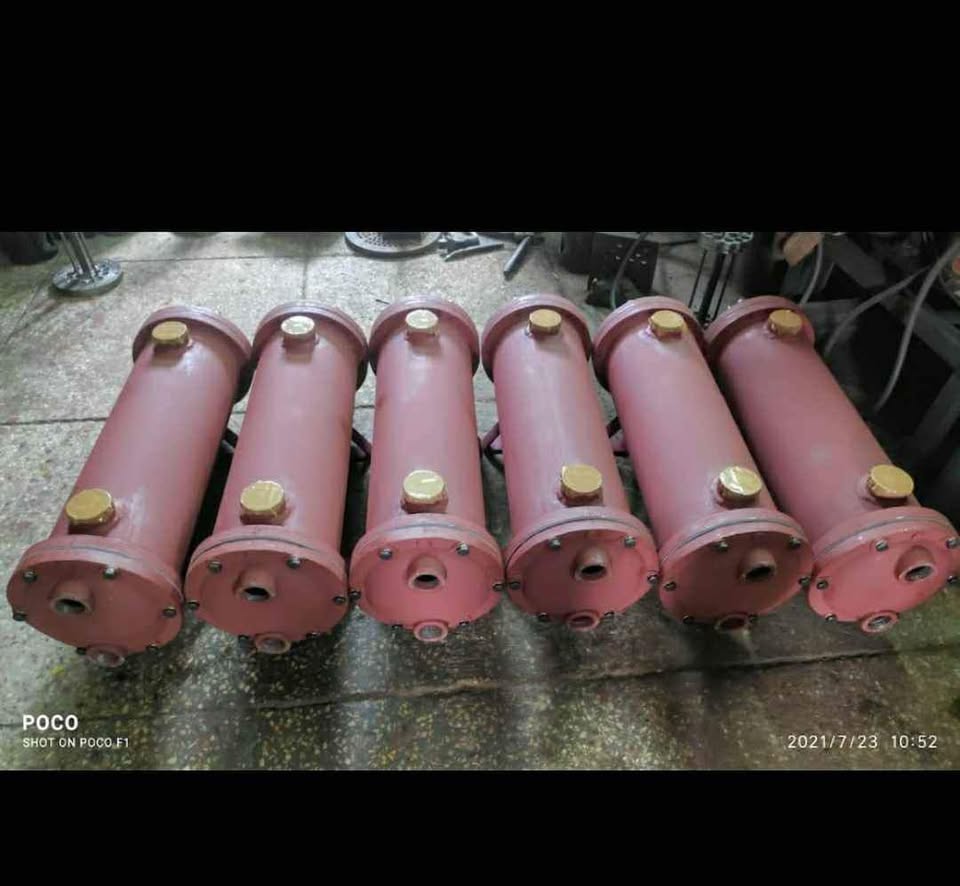Maintaining a shell and tube oil cooler in marine or industrial applications is crucial for efficient heat transfer, preventing leaks, and avoiding costly downtime. Below is a comprehensive maintenance checklist:
1. Routine Inspection & Monitoring
- Visual Checks:
- Look for oil leaks, seawater seepage, or corrosion on the shell, tubes, and end caps.
- Check sacrificial anodes (if fitted) – replace if >50% depleted.
- Temperature & Pressure Monitoring:
- Compare inlet/outlet temps of oil & coolant – a higher ∆T indicates fouling.
- Monitor pressure drop – Increased pressure drop = clogged tubes.
2. Cleaning Procedures
A. Tube Side (Coolant Side – Usually Seawater/Freshwater)
- Mechanical Cleaning (For Heavy Fouling):
- Use nylon brushes or high-pressure water jetting (avoid metal tools to prevent tube damage).
- For seawater-cooled units, remove barnacles, silt, and marine growth.
- Chemical Cleaning (For Scaling/Biofouling):
- Circulate mild acidic (citric/phosphoric acid) or alkaline solutions to dissolve deposits.
- For Cu-Ni tubes: Avoid strong acids (can cause dezincification).
B. Shell Side (Oil Side)
- Solvent Flushing:
- Use kerosene or diesel to dissolve sludge/varnish deposits.
Hot Oil Flushing (For Heavy Contamination
- Circulate hot oil (80-100°C) with turbulent flow to dislodge carbon deposits.
3. Leak Testing & Repairs
- Hydrostatic Test:
- Pressurize the water side with freshwater to check for leaks (1.5x working pressure).
- Dye Penetrant Test:
- For detecting cracks in tube-to-tube sheet joints.
- Tube Plugging:
- If leaks are found, plug damaged tubes (max 10% of total tubes to avoid efficiency loss).
4. Corrosion Prevention
- Sacrificial Anodes:
- Replace zinc anodes annually (for seawater-cooled units).
- Cathodic Protection (For CS Shells):
- Install impressed current systems in aggressive environments.
- Protective Coatings:
- Apply epoxy or rubber lining on carbon steel shells.
5. Gasket & Seal Maintenance
- Inspect gaskets (between end caps & shell) for hardening or cracks.
- Replace with nitrile (NBR) or EPDM gaskets (compatible with oil & coolant).
6. Operational Best Practices
- Avoid Cold Starts:
- Preheat oil before circulation to prevent thermal shock on tubes.
- Maintain Flow Rates:
- Too low → Fouling | Too high → Erosion.
- Use Strainers/Filters:
- Install dual strainers (100-150 mesh) on the coolant inlet to block debris.
Maintenance Schedule
| Task | Frequency |
| Visual Inspection | Weekly |
| Pressure Drop Check | Monthly |
| Tube Cleaning (Mechanical) | Every 6-12 months |
| Hydrostatic Test | Annually |
| Anode Replacement | Annually (or at 50% wear) |
Troubleshooting Common Issues
| Problem | Possible Cause | Solution |
| High Oil Temp | Fouled tubes/low coolant flow | Clean tubes, check pumps |
| Oil in Coolant | Leaking tube or gasket | Pressure test & plug/repair |
| Coolant in Oil | Tube rupture | Isolate cooler, replace tubes |
| Vibration & Noise | Loose baffles/erosion | Tighten/replace supports |
When to Replace the Oil Cooler?
- If >10% tubes are plugged.
- Severe corrosion (pitting, cracks in tubes/shell).
- Chronic leaks that can’t be repaired.
Final Tips
- For seawater-cooled units: Prioritize titanium tubes for longer life.
- Keep maintenance logs – Helps predict failure patterns.
- Train crew on early signs of cooler failure (temp spikes, pressure drops).
